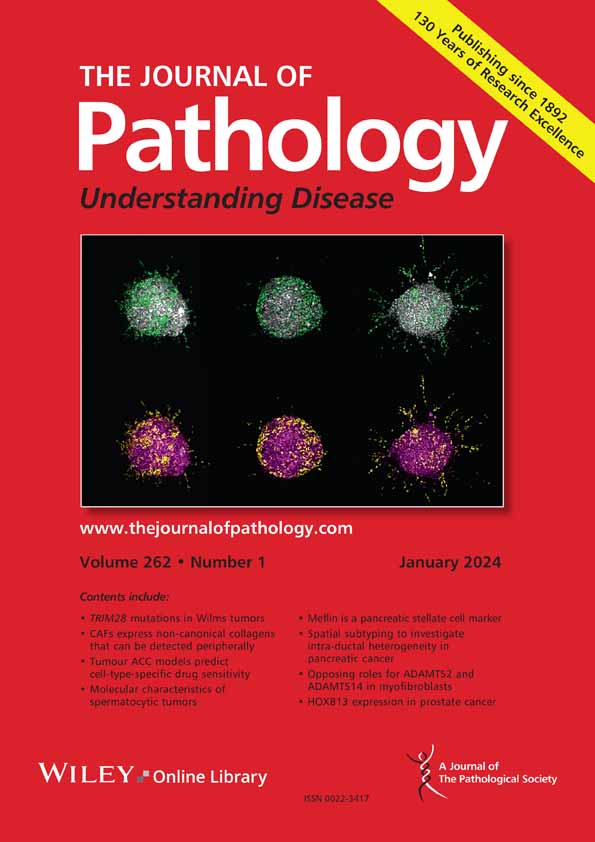Larissa E Vlaming-van Eijk, Guolu Tang, Arno R Bourgonje, Wilfred F A den Dunnen, Jan-Luuk Hillebrands, Harry van Goor
下载PDF
{"title":"Post-COVID-19 condition: clinical phenotypes, pathophysiological mechanisms, pathology, and management strategies","authors":"Larissa E Vlaming-van Eijk, Guolu Tang, Arno R Bourgonje, Wilfred F A den Dunnen, Jan-Luuk Hillebrands, Harry van Goor","doi":"10.1002/path.6443","DOIUrl":null,"url":null,"abstract":"<p>Post-COVID-19 condition (PCC), also known as long COVID, is a complex multiple organ system condition that can develop and persist for months after acute COVID-19. PCC encompasses a wide range of symptoms, resulting in heterogeneous clinical manifestations. These manifestations likely arise from diverse underlying pathophysiological mechanisms, which, in turn, are influenced by risk factors such as age, sex, and comorbidities. To this end, characterising clinical phenotypes of PCC is essential for deepening our understanding of its (potentially) distinct pathophysiological mechanisms and for advancing diagnostic and patient-tailored management strategies. PCC is thought to result from a complex interaction of various pathophysiological mechanisms, leading to functional and structural pathological alterations across multiple organ systems. Investigating these alterations is critical to improving our currently incomplete understanding of PCC's complex pathophysiology. This review provides an overview of the main clinical phenotypes of PCC, characterises these phenotypes by examining symptoms and signs, as well as the associated risk factors. The main hypothesised pathophysiological mechanisms are discussed by outlining the current knowledge on PCC pathology, focussing on the most commonly affected organ systems. Current PCC management includes supportive care such as physiotherapy and the repurposing of existing drugs primarily targeting persistence of SARS-CoV-2 (e.g. antivirals, monoclonal antibodies) and immune dysfunction (e.g. antiinflammatory drugs, immunomodulators). To date, prevention of SARS-CoV-2 infection remains critical, which can be achieved through effective public health measures and vaccination strategies. Finally, this review highlights current knowledge gaps and proposes future research directions to advance the understanding and treatment of PCC. © 2025 The Author(s). <i>The Journal of Pathology</i> published by John Wiley & Sons Ltd on behalf of The Pathological Society of Great Britain and Ireland.</p>","PeriodicalId":232,"journal":{"name":"The Journal of Pathology","volume":"266 4-5","pages":"369-389"},"PeriodicalIF":5.2000,"publicationDate":"2025-06-10","publicationTypes":"Journal Article","fieldsOfStudy":null,"isOpenAccess":false,"openAccessPdf":"https://onlinelibrary.wiley.com/doi/epdf/10.1002/path.6443","citationCount":"0","resultStr":null,"platform":"Semanticscholar","paperid":null,"PeriodicalName":"The Journal of Pathology","FirstCategoryId":"3","ListUrlMain":"https://pathsocjournals.onlinelibrary.wiley.com/doi/10.1002/path.6443","RegionNum":2,"RegionCategory":"医学","ArticlePicture":[],"TitleCN":null,"AbstractTextCN":null,"PMCID":null,"EPubDate":"","PubModel":"","JCR":"Q1","JCRName":"ONCOLOGY","Score":null,"Total":0}
引用次数: 0
引用
批量引用
Abstract
Post-COVID-19 condition (PCC), also known as long COVID, is a complex multiple organ system condition that can develop and persist for months after acute COVID-19. PCC encompasses a wide range of symptoms, resulting in heterogeneous clinical manifestations. These manifestations likely arise from diverse underlying pathophysiological mechanisms, which, in turn, are influenced by risk factors such as age, sex, and comorbidities. To this end, characterising clinical phenotypes of PCC is essential for deepening our understanding of its (potentially) distinct pathophysiological mechanisms and for advancing diagnostic and patient-tailored management strategies. PCC is thought to result from a complex interaction of various pathophysiological mechanisms, leading to functional and structural pathological alterations across multiple organ systems. Investigating these alterations is critical to improving our currently incomplete understanding of PCC's complex pathophysiology. This review provides an overview of the main clinical phenotypes of PCC, characterises these phenotypes by examining symptoms and signs, as well as the associated risk factors. The main hypothesised pathophysiological mechanisms are discussed by outlining the current knowledge on PCC pathology, focussing on the most commonly affected organ systems. Current PCC management includes supportive care such as physiotherapy and the repurposing of existing drugs primarily targeting persistence of SARS-CoV-2 (e.g. antivirals, monoclonal antibodies) and immune dysfunction (e.g. antiinflammatory drugs, immunomodulators). To date, prevention of SARS-CoV-2 infection remains critical, which can be achieved through effective public health measures and vaccination strategies. Finally, this review highlights current knowledge gaps and proposes future research directions to advance the understanding and treatment of PCC. © 2025 The Author(s). The Journal of Pathology published by John Wiley & Sons Ltd on behalf of The Pathological Society of Great Britain and Ireland.
covid -19后的情况:临床表型、病理生理机制、病理和管理策略。
COVID-19后状况(PCC),也称为长COVID,是一种复杂的多器官系统状况,可在急性COVID-19后发展并持续数月。PCC包括广泛的症状,导致不同的临床表现。这些表现可能源于多种潜在的病理生理机制,而这些机制又受年龄、性别和合并症等危险因素的影响。为此,表征PCC的临床表型对于加深我们对其(潜在的)独特病理生理机制的理解以及推进诊断和患者定制管理策略至关重要。PCC被认为是多种病理生理机制复杂相互作用的结果,导致多器官系统的功能和结构病理改变。研究这些改变对于改善我们目前对PCC复杂病理生理的不完整理解至关重要。这篇综述概述了PCC的主要临床表型,通过检查症状和体征以及相关的危险因素来描述这些表型。主要假设的病理生理机制,通过概述当前知识的PCC病理,集中在最常见的影响器官系统进行讨论。目前的PCC管理包括支持性护理,如物理治疗和现有药物的再利用,主要针对SARS-CoV-2的持久性(如抗病毒药物、单克隆抗体)和免疫功能障碍(如抗炎药物、免疫调节剂)。迄今为止,预防SARS-CoV-2感染仍然至关重要,这可以通过有效的公共卫生措施和疫苗接种战略来实现。最后,本文回顾了目前的知识差距,并提出了未来的研究方向,以促进对PCC的认识和治疗。©2025作者。《病理学杂志》由John Wiley & Sons Ltd代表大不列颠和爱尔兰病理学会出版。
本文章由计算机程序翻译,如有差异,请以英文原文为准。




 求助内容:
求助内容: 应助结果提醒方式:
应助结果提醒方式:


